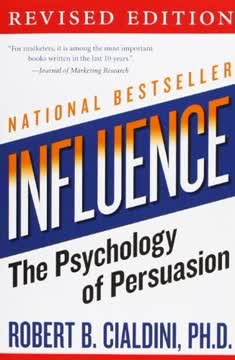Key Takeaways
1. Nonverbal communication is a universal language that reveals our true emotions
From the time we are born until we die, we look to for useful information—first as parents, later as friends, work mates, lovers—to reveal for us what is in the mind.
The power of nonverbals. Our body language often speaks louder than words, revealing our true feelings and intentions. This silent language is rooted in our evolutionary past, with many behaviors hardwired into our DNA. From subtle facial expressions to unconscious gestures, our bodies constantly transmit information about our emotional state, level of comfort, and even our honesty.
Universal and instinctive. Many nonverbal cues are universal across cultures, such as:
- Smiling to express happiness
- Furrowing the brow to show concern
- Crossing arms for self-comfort or protection
- Leaning towards people we like
By understanding these cues, we can better navigate social situations, improve our relationships, and gain valuable insights into others' thoughts and feelings.
2. The face is a canvas of emotions, with each feature telling its own story
The face has more than twenty distinct muscle groups that can create more than four thousand distinct expressions, according to Dr. Paul Ekman.
Facial microexpressions. Our faces are incredibly expressive, capable of conveying a wide range of emotions through subtle movements of muscles. Key areas to observe include:
- Eyes: Widening in surprise, narrowing in suspicion
- Eyebrows: Raising in disbelief, furrowing in concentration
- Mouth: Smiling genuinely (involving eyes) or falsely (mouth only)
- Nose: Wrinkling in disgust
- Jaw: Clenching in anger or stress
Reading facial cues. By paying attention to these facial expressions, we can gain insights into others' emotional states and reactions. However, it's important to consider the context and look for clusters of behaviors rather than relying on a single cue.
3. Body posture and gestures convey confidence, comfort, and internal states
Postural echoing (mirroring) suggests agreement in conversation, mood, or temperament.
Power poses. Our body posture can significantly influence how others perceive us and even how we feel about ourselves. Confident postures include:
- Standing tall with shoulders back
- Taking up space (arms spread, legs apart)
- Maintaining an open stance (uncrossed arms and legs)
Comfort and discomfort. Body language also reveals our level of comfort in different situations:
- Leaning towards someone indicates interest or agreement
- Leaning away suggests discomfort or disagreement
- Mirroring another's posture often occurs unconsciously when we feel rapport
By consciously adopting confident postures and paying attention to others' body positioning, we can improve our interactions and build stronger connections.
4. Hands and feet are powerful indicators of our intentions and feelings
Our hands are constantly communicating to others our passions, our desires, our abilities, our concerns, and most important, through the gentlest of touch, our love.
Hand gestures. Our hands are incredibly expressive and can reveal a lot about our thoughts and emotions:
- Open palms suggest honesty and openness
- Clenched fists may indicate anger or determination
- Fidgeting or self-touching often signals anxiety or discomfort
Foot behavior. Often overlooked, our feet can be surprisingly revealing:
- Pointing towards someone shows interest or engagement
- Pointing away may indicate a desire to leave or discomfort
- "Happy feet" (bouncing or wiggling) can signal excitement or anticipation
By paying attention to these often-unconscious movements, we can gain valuable insights into others' true feelings and intentions.
5. Stress and anxiety manifest in specific physical behaviors
Stress, fear, and apprehension can cause our mouths to dry out (the clinical term for this is xerostomia).
Stress indicators. When we're under pressure, our bodies often display telltale signs:
- Increased blinking or eye movement
- Throat clearing or swallowing
- Neck or face touching
- Lip biting or pursing
- Shallow, rapid breathing
Pacifying behaviors. To cope with stress, we often engage in self-soothing actions:
- Playing with jewelry or objects
- Rubbing hands or arms
- Adjusting clothing
- Hair touching or twirling
Recognizing these behaviors in ourselves and others can help us identify and address stress more effectively.
6. Cultural context shapes the interpretation of body language
In some cultures it is permissible to look at someone for three to four seconds, while in others anything beyond two seconds is considered rude.
Cultural variations. While many nonverbal cues are universal, their specific meanings can vary across cultures:
- Eye contact: Prolonged in some cultures, avoided in others
- Personal space: Varies widely between cultures
- Gestures: May have different meanings (e.g., thumbs-up is offensive in some countries)
Contextual interpretation. To accurately read body language, it's crucial to consider:
- Cultural background
- Situational context
- Individual baseline behaviors
By being aware of these cultural differences and adapting our own nonverbal communication accordingly, we can improve cross-cultural interactions and avoid misunderstandings.
7. Developing nonverbal intelligence enhances personal and professional relationships
Effective leaders listen and transmit on two channels: the verbal and the nonverbal.
Improving nonverbal skills. Enhancing our ability to read and use body language can significantly impact our personal and professional lives:
- Better understanding of others' emotions and intentions
- Improved communication and rapport-building
- Enhanced leadership and negotiation skills
- More authentic and engaging public speaking
Practical application. To develop nonverbal intelligence:
- Observe people in various settings
- Practice active listening, focusing on both words and body language
- Seek feedback on your own nonverbal communication
- Experiment with different postures and gestures to see how they affect your mood and others' perceptions
By honing these skills, we can become more effective communicators, build stronger relationships, and navigate social situations with greater ease and confidence.
Last updated:
FAQ
What's "The Dictionary of Body Language" about?
- Comprehensive Guide: "The Dictionary of Body Language" by Joe Navarro is a detailed field guide to understanding human behavior through nonverbal communication.
- Body Language Insights: It covers over 400 body language cues, from head to feet, explaining what each gesture or movement might indicate about a person's thoughts or feelings.
- Practical Applications: The book is designed to help readers decode body language in everyday situations, enhancing their ability to interpret others' intentions and emotions.
- Author's Expertise: Joe Navarro, a former FBI agent, draws on his extensive experience in behavioral analysis to provide insights that are both practical and scientifically grounded.
Why should I read "The Dictionary of Body Language"?
- Improve Communication Skills: Understanding body language can significantly enhance your ability to communicate effectively and empathetically with others.
- Professional Advantage: In professional settings, being able to read nonverbal cues can give you an edge in negotiations, interviews, and team interactions.
- Personal Relationships: The book offers tools to better understand friends, family, and partners, potentially improving personal relationships.
- Expert Knowledge: Joe Navarro's background as an FBI agent provides a unique perspective on the importance and application of body language in high-stakes situations.
What are the key takeaways of "The Dictionary of Body Language"?
- Nonverbal Communication: Body language is a critical component of communication, often revealing more than spoken words.
- Comfort vs. Discomfort: Many body language cues can be categorized as indicators of psychological comfort or discomfort.
- Cultural Variations: While some gestures are universal, others can vary significantly across different cultures, highlighting the importance of context.
- Practical Exercises: The book encourages readers to practice observing and interpreting body language in real-life situations to improve their skills.
How did Joe Navarro's background influence "The Dictionary of Body Language"?
- FBI Experience: Navarro's 25-year career with the FBI, particularly in behavioral analysis, provided him with firsthand experience in reading body language.
- Real-World Application: His work involved interviewing criminals and spies, where understanding nonverbal cues was crucial for gathering information.
- Scientific Approach: Navarro combines his practical experience with scientific research to offer a comprehensive understanding of body language.
- Cultural Adaptation: His personal journey from Cuba to the U.S. required him to adapt to new cultural norms, enhancing his sensitivity to nonverbal communication.
What are some specific body language cues discussed in "The Dictionary of Body Language"?
- Head Movements: Includes nodding, head tilting, and head scratching, each with different implications for agreement, curiosity, or confusion.
- Eye Behavior: Covers pupil dilation, eye contact, and blinking rates, which can indicate interest, stress, or deception.
- Hand Gestures: Discusses steepling, hand wringing, and finger pointing, which can convey confidence, anxiety, or aggression.
- Posture and Positioning: Explores how body orientation and posture can signal openness, defensiveness, or dominance.
How does "The Dictionary of Body Language" address cultural differences in body language?
- Cultural Context: The book emphasizes the importance of understanding cultural norms when interpreting body language, as gestures can have different meanings in different cultures.
- Examples Provided: Navarro provides specific examples of gestures that vary across cultures, such as the meaning of eye contact or handshakes.
- Universal vs. Cultural: While some body language cues are universal, others are deeply rooted in cultural practices, requiring careful consideration.
- Practical Advice: Readers are encouraged to learn about cultural differences to avoid misinterpretations, especially in international or multicultural settings.
What are the best quotes from "The Dictionary of Body Language" and what do they mean?
- "If language was given to men to conceal their thoughts, then gesture’s purpose was to disclose them." This quote highlights the idea that body language often reveals what words may hide.
- "Our bodies reveal very accurately, in real time, our state of unease." It underscores the reliability of nonverbal cues in indicating discomfort or stress.
- "People often lie, but their nonverbals usually reveal how they actually feel." This emphasizes the importance of observing body language to discern true emotions.
- "The nonverbal cues we give, and those we notice in others, matter significantly." It stresses the impact of body language on communication and relationships.
How can "The Dictionary of Body Language" be applied in professional settings?
- Interviewing Skills: Understanding body language can help interviewers assess candidates' confidence and honesty.
- Negotiation Tactics: Recognizing nonverbal cues can provide insights into the other party's level of agreement or resistance.
- Leadership Development: Leaders can use body language to project confidence and build rapport with their teams.
- Conflict Resolution: Identifying signs of discomfort or aggression can aid in de-escalating tense situations.
What are some common misconceptions about body language addressed in "The Dictionary of Body Language"?
- Deception Myths: Navarro clarifies that no single gesture definitively indicates lying; context and clusters of behaviors are crucial.
- Cultural Misunderstandings: The book dispels the notion that all body language is universal, highlighting the need for cultural awareness.
- Overinterpretation: Readers are cautioned against overanalyzing isolated gestures without considering the overall context and baseline behaviors.
- Infallibility: While body language is informative, it is not infallible and should be used in conjunction with other communication cues.
How does "The Dictionary of Body Language" suggest improving one's ability to read body language?
- Observation Practice: The book encourages regular observation of people in various settings to hone body language reading skills.
- Acting Out Cues: Readers are advised to act out behaviors described in the book to better understand and remember them.
- Contextual Awareness: Emphasizes the importance of considering the context and baseline behaviors when interpreting body language.
- Feedback and Reflection: Suggests seeking feedback from others and reflecting on personal experiences to improve accuracy in reading nonverbal cues.
What are some practical exercises from "The Dictionary of Body Language" to enhance understanding?
- People Watching: Spend time observing people in public places, noting their body language and hypothesizing about their emotions or intentions.
- Mirror Practice: Use a mirror to practice and recognize your own body language, improving self-awareness and control.
- Role-Playing: Engage in role-playing exercises with friends or colleagues to practice interpreting and responding to nonverbal cues.
- Journaling Observations: Keep a journal of body language observations and reflections to track progress and insights over time.
How does "The Dictionary of Body Language" address the role of technology in nonverbal communication?
- Digital Limitations: The book acknowledges that digital communication lacks the richness of face-to-face interactions, where body language plays a crucial role.
- Video Conferencing: Suggests paying attention to available nonverbal cues, such as facial expressions and tone of voice, during video calls.
- Social Media: Highlights the challenges of interpreting emotions accurately through text-based communication without nonverbal context.
- Balancing Technology: Encourages maintaining a balance between digital and in-person interactions to preserve the depth of human communication.
Review Summary
What Every Body Is Saying receives mixed reviews, with an average rating of 3.91/5. Many readers find it informative and eye-opening, praising Navarro's expertise and real-life examples. The book is lauded for its detailed explanations of body language cues and their meanings. However, some critics find it repetitive, obvious, or overly focused on law enforcement scenarios. Several reviewers note that while interesting, the information may be challenging to apply in everyday situations. Despite some criticisms, many readers recommend it as a solid introduction to nonverbal communication.
Similar Books










Download PDF
Download EPUB
.epub digital book format is ideal for reading ebooks on phones, tablets, and e-readers.








